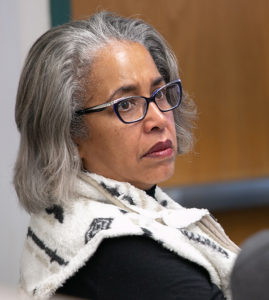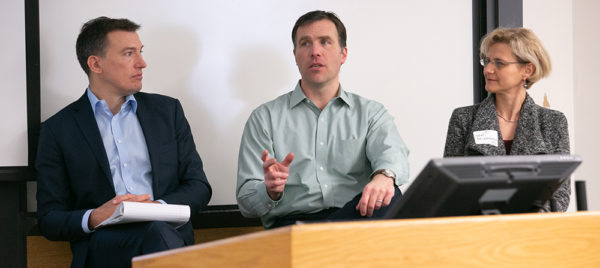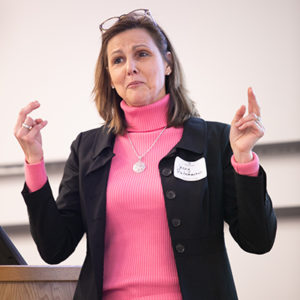Interdisciplinary Research Takes Center Stage

Bring faculty members from across campus together, and something magical happens. New connections are made, new questions are posed and debated, and new research ideas are sparked.
“That’s the whole essence of collision spaces,” said Adam Sulkowski, associate professor of law and sustainability. “You don’t know when the insight will hit and from whom.”
Ideas and insights were colliding in unexpected and exciting ways throughout the fourth annual Babson Faculty Research Day on January 24 at Malloy Hall.
Many of the research projects presented this year took an interdisciplinary approach. That wasn’t an intentional part of the original design, but it wasn’t a coincidence either, said David Nersessian, an associate professor in the Accounting and Law Division.
“The day is reflective of the things that are happening at Babson,” Nersessian said, “but without the day, we wouldn’t necessarily know about those things.”
Faculty members were not only informed but also inspired during a day that featured 25 paper presentations and six panels involving close to 60 faculty members from every division.
‘We Look at Problems Differently’
The interdisciplinary theme ran throughout the day with professors from accounting, economics, entrepreneurship, history and society, and other divisions collaborating in various presentations.

And, that was before the concluding panel on interdisciplinary research itself, which featured faculty from marketing; accounting and law; math and science; and arts and humanities.
“Because of the interdisciplinary nature (of Babson), we try to show connections between the business disciplines but also liberal arts and business,” said Donna Stoddard, associate professor and chair of the Technology, Operations, and Information Management (TOIM) Division. “That’s really what makes Babson a different place than a lot of other business schools.”
Rubén Mancha, an assistant professor of information systems, said that interdisciplinary approach is what attracted him to Babson nearly five years ago.
“We look at problems differently,” he said of his colleagues. “We don’t engage as people in different disciplines. We try to embrace the different lenses and frameworks and look at the problem to solve the problem. So, it’s very entrepreneurial in that sense. And, we are not simply engaging in research for the sake of publication and theory; we’re really trying to learn from each other and trying to identify how to better solve challenges.”

Faculty Research Day—originally the brainchild of Nersessian four years ago—not only encourages but also accelerates those connections, collaborations and research opportunities across divisions.
“The creativity required to solve important business problems increasingly will build on imagination disciplines, like writing, literature, drama, art, and those kinds of things,” Nersessian said. “Babson is a place where you can work with someone in those areas as well as business fields and where the collaboration is really valued. One of the really great things about being here is that we’re not disciplinary purists.”
For many faculty members, research day is not just the culmination of months or years of research but oftentimes just the beginning, as the seeds for future collaboration and additional research ideas are planted.
“It leads to a lot of conversations offline, and it leads to several weeks of high-intensity meetings,” said Mancha, who already has collaborated with nearly a dozen colleagues across campus. “I have at least three meetings already scheduled just coming out of different sessions with people who want to catch up about different projects.”

‘A Relatively Unique Phenomenon’
The cross-discipline research and discussion made a special impression on one attendee in particular: President Stephen Spinelli Jr. MBA’92, PhD.

Spinelli not only attended the event but also actively participated in both of the morning sessions. Sitting in a Malloy classroom, Spinelli took notes on his iPad and then engaged in robust back-and-forth discussions with presenters during the first session on Sharing Economy and Social Responsibility.
“I am mostly intrigued here at Babson with the transdisciplinary approach that a lot of the research seems to take,” Spinelli said in his address to faculty over lunch, making the point that Babson’s approach dissolves boundaries between disciplines rather than simply crossing them.
“I find it a relatively unique phenomenon in higher education that is so disciplinary based. To find the disciplinary expertise and the transdisciplinary warmth and understanding to put a paper together that is of the quality of the work that I have seen here is pretty special.”

Jenny Rademacher, associate professor of Hispanic literature and cultural studies, said Spinelli’s active engagement was an important symbol of how a small community such as Babson’s is invested in each other.
Plus, getting an enthusiastic reception—from the president and from colleagues—during a presentation is uplifting.
“Being able to see that those ideas resonate with someone else is the most fulfilling kind of thing,” Rademacher said. “It’s nice when it’s your colleagues, because then you can think about all sorts of opportunities for collaboration and for ways that your work might be enriched … and it sort of builds the pipeline.”




